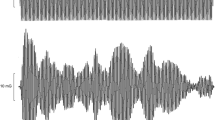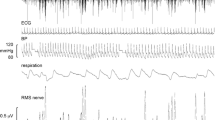Abstract
There is evidence in experimental animals for a potent vestibulosympathetic reflex, but its existence in humans is controversial. Static head-down neck flexion and off-vertical axis rotation have been shown to increase muscle sympathetic nerve activity (MSNA), but not skin sympathetic nerve activity (SSNA), whereas horizontal linear acceleration decreases MSNA in humans. However, both forms of stimuli also activate other receptors. To examine the effects of a pure vestibular stimulus on MSNA and SSNA, and its potential interaction with the baroreceptors, we used galvanic vestibular stimulation (GVS) in 12 healthy seated subjects. MSNA was recorded in ten subjects via a percutaneous microelectrode in the peroneal nerve; ECG, blood pressure, respiration, skin blood flow and sweating were also recorded. GVS (2 mA, 1 s pulse) was delivered via surface electrodes over the mastoid processes at unexpected times, triggered from the R-wave with a delay of 0, 200, 400 or 600 ms. In addition to causing robust postural illusions, GVS caused cutaneous vasoconstriction and sweat release in all subjects (due to a short-latency increase in SSNA, three subjects), but no significant change in MSNA. The failure of GVS to elicit a change in muscle sympathetic nerve activity, as documented by averaging, suggests that the vestibular system is not engaged in short-term modulation of muscle sympathetic activity. Conversely, phasic vestibular inputs do excite cutaneous sympathetic neurones, consistent with the observation that motion sickness is accompanied by pallor and sweating.



Similar content being viewed by others
References
Benson AJ (1999) Motion sickness. In: Ernsting J, Nicholson AN, Rainford DJ (eds) Aviation Medicine. Butterworth Heinemann, Oxford, pp 455–471
Bolton PS, Ray CA (2000) Neck afferent involvement in cardiovascular control during movement. Brain Res Bull 53:45–49
Bolton PS, Wardman DL, Macefield VG (2002) Effects of galvanic stimulation on sympathetic outflow in awake human subjects. Proc Aust Neurosci Soc 13:96
Britton TC, Day BL, Brown P, Rothwell JC, Thompson PD, Marsden CD (1993) Postural electromyographic responses in the arm and leg following galvanic vestibular stimulation in man. Exp Brain Res 94:143–151
Burke D, Sundlof G, Wallin BG (1977) Postural effects on muscle nerve sympathetic activity in man. J Physiol 272:399–414
Costa F, Lavin P, Robertson D, Biaggioni I (1995) Effect of neurovestibular stimulation on autonomic regulation. Clin Auton Res 5:289–293
Cui J, Mukai C, Iwase S, Sawasaki N, Kitazawa H, Mano T, Sugiyama Y, Wada Y (1997) Response to vestibular stimulation of sympathetic outflow to muscle in humans. J Autonom Nerv Sys 66:154–162
Cui J, Iwase S, Mano T, Katayama N, Mori S (2001) Muscle sympathetic outflow during horizontal linear acceleration in humans. Am J Physiol Regul Integr Comp Physiol 281:R625–R634
Day BL, Severac-Cauquil A, Bartolomei L, Pastor MA, Lyon IN (1997) Human body-segment tilts induced by galvanic stimulation: a vestibularly driven balance protection mechanism. J Physiol 500:661–672
Doba N, Reis DJ (1974) Role of the cerebellum and the vestibular apparatus in regulation of orthostatic reflexes in cats. Circ Res 40:9–18
Donadio V, Kallio M, Karlsson T, Nordin M, Wallin BG (2002) Inhibition of muscle sympathetic activity by sensory stimulation. J Physiol 544:285–292
Fagius J, Wallin (1980) Sympathetic reflex latencies and conduction velocities in normal man. J Neurol Sci 47:433–448
Fitzpatrick R, Burke D, Gandevia SC (1994) Task-dependent reflex responses and movement illusions evoked by galvanic vestibular stimulation in standing humans. J Physiol 478:363–372
Fu Q, Iwase S, Niimi Y, Kamiya A, Kawanokuchi J, Cui J, Mano T, Suzumura A (2001) Effects of lower body positive pressure on muscle sympathetic nerve activity response to head-up tilt. Am J Physiol Regul Integr Comp Physiol 281:R778–785
Hume KM, Ray CA (1999) Sympathetic responses to head-down rotations in humans. J Appl Physiol 86:1971–1976
Iwase S, Mano T, Saito M (1987) Effects of graded head-up tilting on muscle sympathetic activities in man. Physiologist 30[Suppl 1]):S62–63
Jian BJ, Cotter LA, Emanuel BA, Cass SP, Yates BJ (1999) Effects of bilateral vestibular lesions on orthostatic intolerance in awake cats. J Appl Physiol 86:1552–1560
Kaufmann H, Biaggioni I, Voustianiouk A, Diedrich A, Costa F, Clarke R, Gizzi M, Raphan T, Cohen B (2002) Vestibular control of sympathetic activity. An otolith-sympathetic reflex in humans. Exp Brain Res 143:463–469
Kerman IA, Yates BJ, McAllen RM (2000) Anatomic patterning in the expression of vestibulosympathetic reflexes. Am J Physiol Regul Integr Comp Physiol 279:R109–R117
Macefield VG, Wallin BG (1995a) Modulation of muscle sympathetic activity during spontaneous and artificial ventilation and apnoea in humans. J Autonon Nerv Syst 53:137–147
Macefield VG, Wallin BG (1995b) Effects of static lung inflation on sympathetic activity in human muscle nerves at rest and during asphyxia. J Autonon Nerv Syst 53:148–156
Macefield VG, Taylor JL, Wallin BG (1998) Inhibition of muscle sympathetic outflow following transcranial cortical stimulation. J Autonon Nerv Syst 68:49–57
Ray CA, Hume KM (1998) Neck afferents and muscle sympathetic activity in humans: implications for the vestibulosympathetic reflex. J Appl Physiol 84:450–453
Shortt TL, Ray CA (1997) Sympathetic and vascular responses to head-down neck flexion in humans. Am J Physiol Regul Integr Comp Physiol 272:H1780–H1784
Silber DH, Sinoway LI, Leuenberger UA, Amassian VE (2000) Magnetic stimulation of the human motor cortex evokes skin sympathetic nerve activity. J Appl Physiol 88:126–134
Wardman DL, Fitzpatrick RC (2002) What does galvanic vestibular stimulation stimulate? Adv Exp Biol Med 508:119–128
Yates BJ (1996) Vestibular influences on the autonomic nervous system. Ann NY Acad Sci 781:458–473
Yates BJ, Miller AD (1994) Properties of sympathetic reflexes elicited by natural vestibular stimulation: implications for cardiovascular control. J Neurophysiology 71:2087–2092
Yates BJ, Yamagata Y, Bolton PS (1991) The ventrolateral medulla of the cat mediates vestibulosympathetic reflexes. Brain Res 552:265–272
Yates BJ, Goto T, Bolton PS (1993) Responses of neurons in the rostral ventrolateral medulla of the cat to natural vestibular stimulation. Brain Res 601:255–264
Acknowledgments
VGM is a Senior Research Fellow of the National Health and Medical Research Council of Australia. DLW was supported by a grant from the National Health and Medical Research Foundation. PSB is supported in part by a grant to the Hunter Medical Research Institute from the NSW Dept of Health.
Author information
Authors and Affiliations
Corresponding author
Rights and permissions
About this article
Cite this article
Bolton, P.S., Wardman, D.L. & Macefield, V.G. Absence of short-term vestibular modulation of muscle sympathetic outflow, assessed by brief galvanic vestibular stimulation in awake human subjects. Exp Brain Res 154, 39–43 (2004). https://doi.org/10.1007/s00221-003-1631-1
Received:
Accepted:
Published:
Issue Date:
DOI: https://doi.org/10.1007/s00221-003-1631-1




